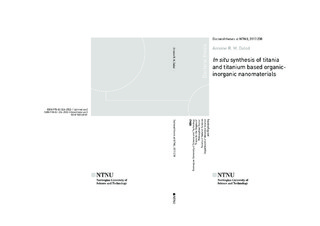| dc.description.abstract | Inorganic and organic materials often exhibit opposite trends in properties (e.g. mechanical properties, thermal stability, hydrophobicity, optical properties) and the idea of combining these materials into new materials with unique and tunable properties has thus gain increased interest from the research and industrial communities. In collaboration with an industrial partner, poLight AS, the main objective of the project was to develop a new transparent polymer nanocomposite with high refractive index to be used in an actuator-based optical lens. For potential industrial use of the technology, key parameters were simplicity, cost efficiency, and environmental friendliness of the processes.
The work was divided in two parts. The first one consisted of the synthesis of titania nanoparticles via hydrothermal synthesis. The particles were functionalized during the process in order to modify the surface chemistry to a hydrophobic behavior, and thus to obtain a better dispersion in organic polymers. Depending on the nature of the silane coupling agent used for the functionalization, the resulting nanomaterials exhibited different morphology (spheres or mixture of spheres and elongated rod-like nanoparticles). The synthesis conditions (pH, time, precursor ratios) were thoroughly investigated to determine the contribution of each parameter and to elucidate the reaction mechanisms. In the second part, a non-aqueous sol-gel approach was used to prepare titanium-polydimethylsiloxane hybrid nanomaterials in a single-step synthesis, allowing to form titanium rich nanodomains directly within the polymeric matrix. The resulting materials were characterized at different length scales using complementary techniques in order to establish the links between the synthesis conditions (composition and temperature), the nanostructures, and the properties of the materials (transparency, refractive index, and mechanical properties). The main findings of the thesis concern optimization of the synthesis procedures, the involved reaction mechanism, and their direct effect on the resulting organic-inorganic nanomaterials. | nb_NO |
